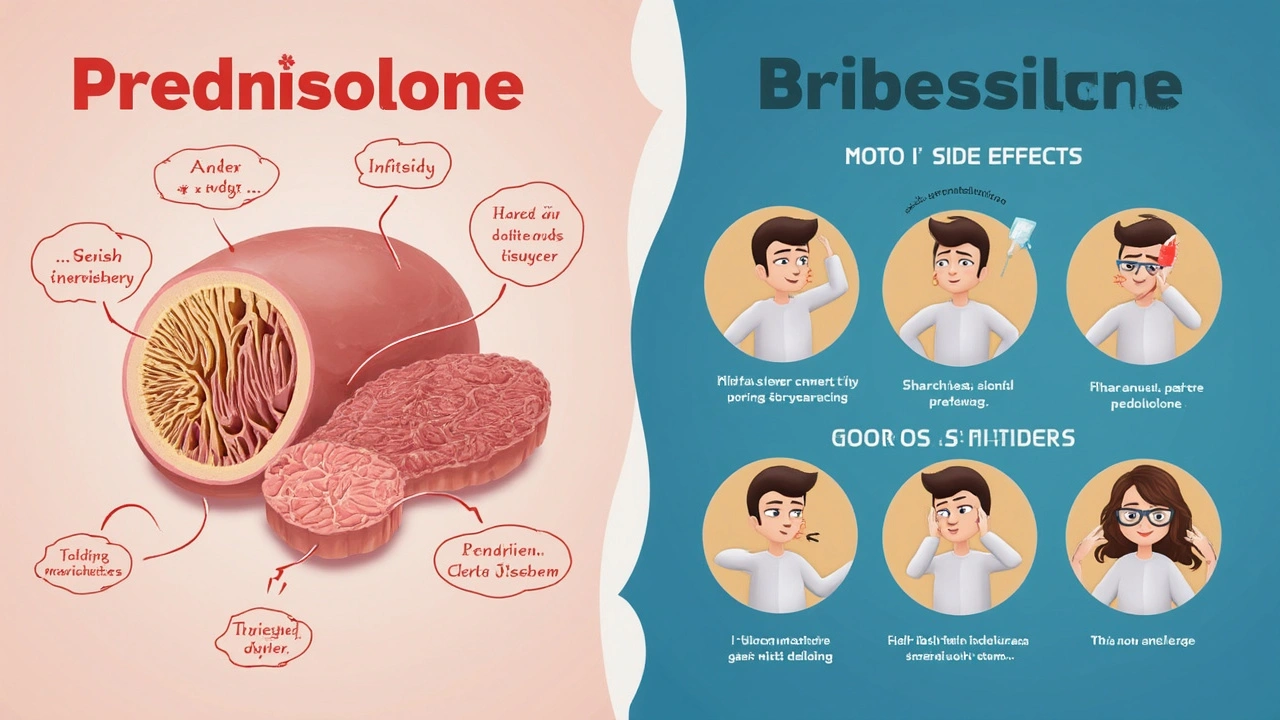Imagine waking up with every joint throbbing, your skin itching, or your lungs desperately gasping for air. Prednisolone, a medication that sounds more like a character from a superhero movie than a tiny white pill, steps in for millions needing relief from these nightmares. The drug isn’t new—it’s been around since the late 1950s, and it's still a go-to for doctors trying to put out the fires of inflammation raging inside your body. Strangely, just one little tablet can shift the course of a disease, helping people walk, breathe, or even keep their eyesight. But for all its power, prednisolone is a double-edged sword. Knowing how it works, its risks, and how to use it smartly can make this medicine your ally rather than your foe.
What Exactly Is Prednisolone and How Does It Work?
Prednisolone is a type of corticosteroid, which means it’s a synthetic copy of hormones your adrenal glands make every day. These hormones help control things like immune response, metabolism, and the way your body handles stress. But when something goes haywire—like during an autoimmune flare, a sudden allergy, or severe asthma—the body’s natural steroids just aren’t enough. Enter prednisolone, usually swallowed as a tablet or sometimes given through an injection or as eye drops. What it really does is calm down the immune system and reduce inflammation, basically telling those overactive immune cells to take a seat for a while.
Doctors reach for prednisolone when a patient’s body attacks itself—think diseases like rheumatoid arthritis, lupus, or ulcerative colitis. It’s also a lifesaver in emergencies like asthma attacks or severe allergic reactions. Eye doctors even prescribe it to keep inflammation down after eye surgery. The catch? This drug isn’t picky about what kind of immunity it suppresses, so while it’s blocking the bad stuff, it can also put the brakes on your body’s ability to fight off infection.
There are some fascinating science facts about how fast prednisolone acts. For instance, after taking a dose by mouth, it usually starts working within a few hours, ramping up to full effect over a couple of days. This makes it a go-to option for everything from skin rashes that appear overnight to chronic illnesses spinning out of control. A cool tip: experts have noticed that timing your dose in the morning can reduce some side effects because it’s when your body naturally produces more corticosteroids.
Need a quick peek at how it stacks up against the competition? Check out this comparison of common corticosteroids and their anti-inflammatory strength:
| Drug | Relative Strength | Typical Dose (mg) |
|---|---|---|
| Hydrocortisone | 1 | 20 |
| Prednisolone | 4 | 5 |
| Methylprednisolone | 5 | 4 |
| Dexamethasone | 25 | 0.75 |
If you look at that table, you’ll notice that prednisolone is about four times as strong as hydrocortisone, meaning you need less of it to get the same result. That’s great for knocking down inflammation quickly, but it also means side effects can show up if you take too much or for too long.
Something worth knowing: prednisolone comes in different forms. Most people take it by mouth, but you might see it as a liquid (helpful for kids who can’t swallow pills), eye drops (for things like uveitis), or even as an injection if things are really severe and you’re in the hospital. This flexibility is a big part of why it’s still so widely used—even in 2025.

When Is Prednisolone Used, and Who Should Not Take It?
The uses for prednisolone read like a who’s who of tough medical conditions. Doctors pull it into action for arthritis that won’t quit, lupus attacks, asthma flare-ups, sudden vision problems like optic neuritis, and allergic reactions that could become life-threatening. Some people take it short term (think: five days for a nasty asthma attack); others use it for weeks, months, or even years if they have stubborn autoimmune conditions.
Probably the most surprising thing about prednisolone is how many different body systems it touches. Got poison ivy that’s turning you into a human tomato? Prednisolone. Crohn’s disease attacking your gut? Prednisolone. A kid with croup barking like a seal? You guessed it. Even some cancer treatments involve high doses of prednisolone because it quiets down dangerous immune responses and shrinks lymphoid tissue.
Now, here’s the tough part: not everyone should take it or take it the same way. People with active infections like tuberculosis, fungal diseases, or even strong viral infections (like chickenpox or measles) are usually told to steer clear if possible, because their body’s ability to fight is going to slow right down. The same goes for folks with certain psychiatric histories, uncontrolled diabetes, osteoporosis, or a recent surgery. Prednisolone can bring blood sugar levels up, thin bones over time, and even unmask hidden mental health issues—so your doctor has to weigh the benefits against these risks every time.
If you’re pregnant or breastfeeding, prednisolone is only used if your doctor thinks the benefits outweigh the possible downsides. Most experts agree it’s safer than some other steroids, especially if you use it for a short period or at the right doses. But, if you’re on prednisolone, you want tight follow-up because the tiniest genetic differences can affect how your body processes this powerful drug.
Here’s a pro tip for anyone who’s about to start: keep a list of every medication, supplement, or herbal product you take. Prednisolone mixes with a bunch of other compounds in your liver, and some things—like the anti-fungal drug ketoconazole or epilepsy medications—can make it stronger or weaker or send your blood pressure, blood sugar, or mood out of whack. Your pharmacist will double-check, but a handwritten list is pure gold when you’re in a rush or see different doctors.
So, is there anyone for whom prednisolone is a flat-out no? Mostly people with untreated, widespread infections, certain types of hepatitis, or recent live vaccines. The medicine will lower your immune defenses so much that even routine bugs could turn nasty. For everyone else, it’s all about managing the risks one at a time and working closely with your healthcare team.

Prednisolone Dosage, Side Effects, and Smart Tips for Staying Safe
There’s no one-size-fits-all dose for prednisolone. The goal is always to use the lowest, most effective dose for the shortest possible time. For short-term problems, that might mean a high “burst” dose (like 40 mg a day for asthma, tapering over a week), while long-term users might settle in around 5 to 10 mg per day. You’ll see people on anything from 1 mg up to 60 mg per day, depending on the problem and how their body reacts. And if you’re on it for longer than a couple of weeks, your doctor will usually taper you down slowly—suddenly stopping can make your adrenal glands go on strike, and that’s a medical emergency.
The shadow side of prednisolone can’t be ignored. Short-term, you might get insomnia, mood swings, upset stomach, or bursts of energy. Some folks find themselves eating everything in sight or feeling jittery like they’ve had one too many shots of espresso. Stretch that out over months or years, and you’re looking at real-deal risks: weight gain, puffiness (especially in the face), thinning skin, easy bruising, osteoporosis, and higher blood sugar that can tip you into diabetes territory. Kids may experience slowed growth, and everyone’s risk of infection goes up, no matter what age.
For people who need prednisolone regularly, bone health suddenly matters even if they’re nowhere close to retirement age. You might want to ask your doctor about calcium and vitamin D supplements, or even get a bone scan every year or two. On the flipside, blood pressure and cholesterol can creep up, so it’s smart to check those more often as well. Take photos before starting long-term courses—changes in face shape, skin, or eyes can sneak up on you gradually, so you’ll know what’s new and what’s not.
Here’s the good news: most side effects fade away once you taper off. The trick is to start smart. Eat a low-salt, low-sugar diet (prednisolone can cause fluid retention and blood sugar spikes), stay active to keep bones and muscles strong, and don’t skip medications for stomach protection if prescribed. If you ever notice vision changes, black stools, severe abdominal pain, or start feeling confused, call your doctor right away—these are rare but serious reactions that shouldn’t wait for your next appointment.
It sounds wild, but even the time of day you take prednisolone can matter. Taking it in the morning may reduce insomnia and helps match the rhythm of your body’s own steroid hormones. With food is usually better to avoid an upset stomach. If you’re on a tapering schedule, keep your pillbox organized so you don’t mix up the doses. Set reminders on your phone—missing or doubling up doses isn’t just a little mistake, it could be dangerous for your hormones. One more tip: always wear a medical alert bracelet or keep a card in your wallet if you’re taking steroids long-term. In emergencies, paramedics need to know your immune system is suppressed.
Finally, don’t let the long potential side effect list scare you off if your doctor truly believes prednisolone is right for you. Every medication is a calculated risk, and this one often delivers life-changing benefits when used with eyes wide open. Honest conversations, steady check-ins, and small lifestyle tweaks can keep the scales tipping in your favor. When you need it, prednisolone is a real heavy hitter—but you’re the one keeping score.


Comments
Steve Ellis
This article is superbly detailed! Prednisolone is such a double-edged sword, right? On one hand, it can really bring down inflammation and help with autoimmune conditions, which is a lifesaver for many. But on the other hand, the side effects can be pretty daunting if not managed properly.
What I really liked was how the article breaks down the dosing and safety tips in a digestible way. Too often medical write-ups get lost in jargon, but this was clear and approachable.
As someone who's supported friends through steroid treatments, I think these kinds of guides empower people to ask better questions and be vigilant about their health.
Anyone here had experience with prednisolone? What were your biggest challenges or surprises?
July 18, 2025 AT 08:02
Jennifer Brenko
While the article is comprehensive, I can’t stress enough how important it is to not trivialize the risks of such potent steroids. In my experience and research, overprescription is rampant, especially in North America.
Prednisolone is not a magic cure; it requires strict medical supervision to avoid devastating effects like adrenal suppression or serious infections. Patients need to be fully informed and insist on monitoring rather than blindly trusting their doctors.
Also, from a national perspective, I question how much regulatory oversight is in place to protect consumers from pharmaceutical overreach. This is a broader issue affecting not just individual safety but public health.
Did the article mention anything about alternative treatment protocols or minimizing corticosteroid dependence?
July 21, 2025 AT 23:00
Harold Godínez
I noticed a couple of minor grammar points in the article that could be polished for clarity, but overall it was well done.
For example, sometimes it’s better to break long sentences into shorter ones to enhance readability. Also, the phrasing around side effects could use consistent tense usage to avoid confusion.
That aside, I appreciate the balanced approach the article takes, neither demonizing nor overselling prednisolone. Speaking from an editorial standpoint, such neutrality is essential, especially when discussing medications that have both benefits and drawbacks.
Anyone else here interested in the language aspect or do you prioritize content over style?
July 25, 2025 AT 11:11
Sunil Kamle
Oh, how excellently comprehensive this post is! Truly, the intricacies of prednisolone’s action and risks are often overlooked in casual conversation.
Yet, one must remain highly vigilant and precise in dosing lest one suffer the iatrogenic burdens of long-term corticosteroid use. The article's emphasis on safety is most welcome.
It is curious, however, how many patients prefer quick fixes without appreciating the gravity of immune modulation.
I do wonder if there might be emerging alternatives that balance efficacy with fewer adverse effects? This remains a pressing question for medical science.
July 28, 2025 AT 23:22
Michael Weber
There’s a philosophical irony in how prednisolone can be both a salvation and a curse. This article touches on that duality subtly but profoundly.
Our very biology reacts with such complexity to synthetic intervention, it almost feels like a metaphor for life itself — the pain and healing intertwined.
Yet many fail to grasp the profound responsibility in taking such medications, ignoring the potential dissipation of vitality within their own bodies.
Did the author delve enough into the emotional and psychological effects steroid use might prompt? I believe that’s an aspect that merits deeper exploration.
August 1, 2025 AT 11:33
Blake Marshall
i gotta say, this post nailed most stuff but it missed a few basics about how ppl might mess up dosages just cuz they dont read the fine print or dont follow instructions carefully, which can lead to some nasty side-effects.
btw, anyone else felt like doctors sometimes just throw these meds at you and dont really explain the long term stuff enough? i mean seriously it's not like a regular painkiller.
also i'd add, watch out for withdrawal symptoms if you stop suddenly. yo gotta taper the dose.
August 4, 2025 AT 23:44
Shana Shapiro '19
This write-up does a good job explaining the technical parts, but I can’t help feeling uneasy about how prednisolone fits into the larger scheme of pharmaceutical control over patients.
There’s a lot of hidden agendas in promoting steroids like this — what about the ties to big pharma and the encouragement of long-term use to increase profits? Are alternative solutions even being seriously considered?
It’s vital to remain skeptical and ask why so many are prescribed steroids without exhausting less invasive options first.
Do we have enough public awareness on this or are people blindly following prescriptions without understanding consequences? That worries me deeply.
August 8, 2025 AT 11:55
Lindsey Bollig
Thanks for sharing such an informative article! It definitely helps clear up confusing points about prednisolone for those who might be new to corticosteroids.
In my experience helping friends with autoimmune disorders, the key thing is always careful monitoring and communicating with your healthcare provider about any side effects. No medication is without risk, but with good guidance, prednisolone can be a very useful tool.
Also, remember to maintain a healthy lifestyle — diet and exercise can help reduce inflammation naturally which may allow the doctor to lower the steroid dose.
Does anyone have tips on managing the weight gain and mood swings that sometimes come with prednisolone?
August 12, 2025 AT 00:06
Daniel Buchanan
This article seems well-rounded, and it’s critical that people understand how powerful prednisolone is.
Anyone taking this medication should make sure they are educated on both the benefits and risks — and that means asking questions, never assuming it’s safe to take casually or without oversight.
I would add that patients ought to keep a symptom diary to track any changes, which can be invaluable for doctors adjusting treatment.
Does anyone here keep such records? What have you found helpful?
August 15, 2025 AT 12:17
Sierra Bagstad
I appreciate the precision and thoroughness of the article, which navigates the complexity of corticosteroid pharmacology with commendable clarity.
Emphasizing patient education and safety protocols is essential in preventing adverse reactions and misuse.
One point I’d like to highlight further is the need for personalized dosing regimens based on patient-specific factors. A one-size-fits-all approach is rarely appropriate with drugs like prednisolone.
Overall, this post effectively balances scientific detail with practical guidance.
August 19, 2025 AT 00:28
Steve Ellis
Replying to the question about weight gain and mood swings — yes, those can be some of the most challenging parts of steroid therapy. What helped my friend was a combination of regular physical activity and mindfulness practices to manage mood.
Also, working closely with the healthcare provider to adjust the dose when side effects become too disruptive is crucial. Sometimes, even dividing the dose or taking it in the morning helps mitigate sleep problems and mood fluctuations.
It’s a tough balancing act, but definitely possible to make prednisolone less overwhelming with the right strategies. Anyone else have experiences with managing these specific side effects?
August 20, 2025 AT 03:33